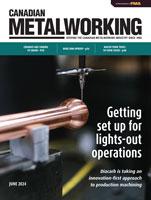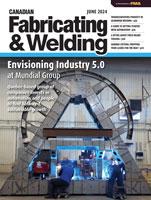Welding Systems Technologist
- FMA
- The Fabricator
- FABTECH
- Canadian Metalworking
Focus on sustainable weld data collection for better results
Clear objectives, implementation road map make data use a success
- By Marc deGier
- June 24, 2024

If you have multiple welding operators in a shop, a certain level of data can help you manage your production. On Fronius i-series machines, different users can log in and log out with their key cards, which can simplify this data-gathering process further. Images: Fronius
Demand for welding data has grown for multiple reasons. For some companies, it is a simple requirement, like a check box that needs to be marked, to determine that a job was finished correctly within specifications. Other companies dive deep into collecting, storing, and analyzing the data to improve their efficiency and quality.
But data collection and analysis can be time-consuming; sustainability must be at the heart of any data management processes. Resources are scarce, so it’s important to take a holistic approach to data management.
Purpose
Usually when a manufacturer approaches Fronius wanting to adopt Industry 4.0 connectivity in its welding department, the first thing we ask is, “What is your objective? What goals are you trying to reach? Are you addressing a specific problem?" Because so much data is available, and there are many levels of engagement in data collection possible in a shop, it’s important to consider the road that will solve a specific concern.
For instance, today we see many companies that have a hard time finding qualified personnel within their budget. Unfortunately, this means that many workers that are hired lack the knowledge or experience to consistently meet stringent welding quality requirements. Data monitoring can help with this issue, as it is now possible to check if welds were done within the right parameters. Cloud-based systems can be used to connect a welder to the internet and monitor the welding activity from anywhere in the world.
Saving welding parameters and settings into jobs on welding power sources helps save a lot of time. Similarly, on some welding machines like the Fronius i-series, parameters can be stored and then copied and pasted from one machine to another, so that new workers don’t have to spend time finding the right parameters. This can improve overall efficiency and reduce waste.
For very large companies, server-based software can be used to compare the cost of production lines in terms of welding wire consumption, welding gas, and electrical energy. It also can be used to quickly compare actual production costs to initial estimates.
For smaller companies, the key takeaway may simply be to understand their resource use and observe who their top performers are to provide a baseline for creating more efficiencies more clearly. The point is, if there are multiple welding operators in a shop, a certain level of data can help a company manage its production. Some machines have tools that allow the operator to log in and log out using a key card can simplify this data-gathering process.
Implementation
Once a company has implemented a system, it should ask itself, “Did we reach the goal or some of our goals?” In more than one instance, a company reached a goal but created three other problems in the process because it wasn’t implemented properly.
For example, if a company looks at shift efficiencies without first discussing its data monitoring with those affected, some employees may feel that they aren’t considered trustworthy and could quit as a result. If team members see data collection as a simple cash grab by management, buy-in could be difficult.
Data collection must be an open discussion where management explains what the company is trying to achieve. Some companies will go to their team and say, “We are trying to generate a profit so that we can win more work and continue growing.” On a related note, some companies set up a profit-sharing scheme: if the shop runs a certain number of parts at the correct quality level, then there will be a benefit for everyone. A focus on sustainability is key, as reducing scrap parts and overall waste greatly benefits the environment and the company’s bottom line.

How you decide to route data can vary. It may be that you want to export that information to an ERP system, or a custom-written software system. Fronius offers various API’s such as MQTT, OPC-UA and REST, to make welding data available to third party software.
A company might also say that the monitoring is there to determine what extra training might be helpful to the team to make sure they have the resources they require to be successful. Today, no one gains from losing team members. Used correctly, these tools can help guide staff growth.
It’s also important for shops to evaluate how parts arrive to the welding department. How precise are the cuts and bends on those parts? Do other processes need to be cleaned up before jumping into data collection? Ultimately, Industry 4.0 should be implemented after a certain baseline level of quality is achieved throughout a shop. An open and candid discussion between management and team members will determine if other initial projects will need to be tackled first.
Scale
A company should be realistic about the scale of the data collection process it hopes to introduce. Again, resources are scarce. Smaller shops must be sure that the expense and time involved match the potential benefits.
For a small shop, it may be that the welding machines are preset for the correct parameters. The data review at the end of the day may simply be to determine whether the team stayed within the correct parameters for each part. If a team member strays from those parameters, the data can help them understand those issues.
Every company considering data collection and analysis should understand what information is available to them from their welding machines. A great deal can be gathered by simply plugging into a machine without adding layers of complexity to the process. It makes sense to implement Ethernet and/or Wi-Fi into every production facility to make it easier to gain access to welding data.
For instance, Fronius machines record the start and stop time for each weld, along with the wire feed speed, voltage, current, and energy that goes into each weld. If users have a certain kilojoule requirement for each weld, that is also recorded. Errors and warnings are logged, and limits can be set up. If a user goes beyond a certain limit (above or below), a warning is triggered. Most modern welding machines store this information. If more information or training is needed, companies should contact their machine provider.
Once a company has a handle on what information is available and how it might be used to improve processes, then it can begin to consider how to more efficiently collect that data.
Big data collection systems offer more storage and more convenient ways in which to read and compare data. After all, a welding power source’s memory either fills up or is overwritten over time. Large data systems that exist on a server allow a company to view year-old data at the click of a button. The right system can filter down to a specific machine, time, part number, and user. Another added benefit is that welding data can be kept private using on-site servers.
How companies route that data can vary as well, including exporting that information to an ERP system or a custom-written software system. Fronius offers various application programming interfaces (APIs), including MQTT, OPC-UA, and REST, that make welding data available to third-party software. It might be tied to a human resources program.
Back to Basics
Ultimately, companies need to discuss how it optimizes wire and gas usage to be more productive and produce more with the resources it has. That conversation needs to be a team discussion, because reducing scrap and waste benefits everyone.
The challenge with data is that it is potentially endless, but a company’s time is valuable, which is why any Industry 4.0 rollout is one that will benefit the bottom line.
Marc deGier is a welding systems technologist at Fronius Canada Ltd., 2875 Argentia Rd., Mississauga, Ont. L5N 8G6, 905-288-2100, degier.marc@fronius.com, fronius.com.
subscribe now


Keep up to date with the latest news, events, and technology for all things metal from our pair of monthly magazines written specifically for Canadian manufacturers!
Start Your Free SubscriptionAbout the Author
Marc deGier
Fronius Canada Ltd.
2875 Argentia Rd.
Mississauga, ON L5N 8G6 Canada
Related Companies
- Trending Articles
Focus on sustainable weld data collection for better results

Plasma cutting system increases cutting speed in 2-in. mild steel

AMADA CANADA hosts grand reopening of Quebec Satellite Center

Two- and three-drawer welding carts available in new design

Promotions announced at MC Machinery Systems

- Industry Events
IMTS 2024
- September 9 - 14, 2024
- Chicago, IL
WiM Summit 2024
- October 6 - 9, 2024
- Boston, MA
FABTECH 2024 Orlando
- October 15 - 17, 2024
- Orlando, FL















